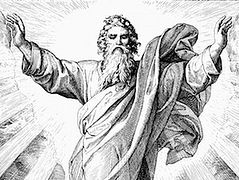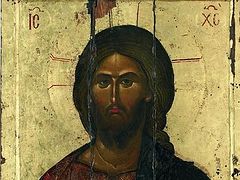According to Orthodox (Byzantine) chronology, rejected by the Western church in the mid 17th century, and by the Russian Church through the reforms of Peter I in the early 18th c., the Birth of Christ took place 5508 years after the creation of “the human race”, or “world”, as Church Slavonic calls it. Professor A. P. Lopukhin in his book The Bible Story of the Old Testament noted the difficulties, but not impossibilty of restoring the chronology of the Old Testament events since Adam.
The goal of this article is to show the results of a calculation of the “5508 years” according to texts of the first translation of the lost original of ancient Hebrew Old Testament Books, made by the Israelite translators from the third to second centuries B.C. (the Septuagint) and preserved up to the twenty-first century in the Bible published by the Russian Bible Society in the Russian language, at the blessing of His Holiness Patriarch Alexei II of Moscow and All Russia.
In the first two chapters of the book of Genesis, are designated the three days of creation. On the sixth day of the period of creation, when the Lord God had not caused it to rain upon the earth… and there went up a mist from the earth (Gen 2:5, 6) and when there was not yet a “bow set in the cloud” (Gen. 9:12-17), God created God created man… Male and female created he them… and called their name Adam [man], in the day when they were created (Gen. 5:1-2). A distinguishing sign of man according to [geneticist Nicholai] Vavilov, is the “homogeneous unit of heredity”; that is, a “gene” with male and female chromosomes.
According to the book of Genesis (cf. Gen. 5:3-31), Adam lived 230 years and begat Seth; Seth lived 205 years and begat Enos. 190 years later Enos begat Cainan; in 170 years Cainan begat Mahalaleel; in 165 years Mahalaleel begat Jared; in 162 years Jared begat Enoch; in 165 years Enoch begat Methuselah; in 187 years Methuselah begat Lamech; in 188 year Lamech begat Noah. And Noah was five hundred years old: and Noah begat Shem, Ham, and Japheth (Gen. 5:32). Inasmuch as Shem is older than Ham and Japheth (cf. Gen. 9:22-24; 10:21), at age 500 years Noah begat Shem. Thus, Shem was born in the year 230+ 205+190+ 170+ 165+ 162+ 165+ 187+ 188+ 500 = 2162 from the day of the creation of man.
And Noah was six hundred years old when the flood of waters was upon the earth (Gen. 7:6). And Noah lived after the (beginning of the) flood three hundred and fifty years. And all the days of Noah were nine hundred and fifty years: and he died (Gen. 9:28-29). The correctness of the inserted words is confirmed by the sum 600 + 350 = 950. By analogy, Shem was an hundred years old (as the flood came upon the earth), and begat Arphaxad two years after the (beginning of the) flood (Gen. 11:10); that is, at the age of 102. Further (cf. Gen. 11:12-25), Arphaxad live 135 years and begat Cainan. After 130 years Cainan begat Salah; in 130 year Salah begat Eber; in 134 years Eber begat Peleg: in 130 years Peleg begat Reu; in 132 year Reu begat Serug; in 130 year Serug begat Nahor; in 79 years Nahor begat Terah. It follows that Terah was born in year 2162 + 102 + 135 + 130 + 130 + 134 + 130 + 132 + 130 + 79 = 3394 from the creation of man.
And Terah lived seventy years, and begat Abram, Nahor, and Haran; the eldest of them was Haran (cf. Gen 11:26-29). Inasmuch as Terah died in Haran at the age of 205, when Abram was 75 (cf. Gen. 11:31-32; 12:4-5), then Terah begat Abram at the age of 205 – 75 = 130. Abram-Abraham begat Isaac at age 100 (cf. Gen. 17:1-6; 21:5). Isaac begat Jacob at age 60 (cf. Gen. 25:25-26; 35:28); that is, in the year 3394 + 130 + 100 + 60 = 3554 from the creation of man.
Jacob begat Joseph (cf. Gen. 30:22-24). At age 17 Joseph was sold by his brothers into Egyptian slavery (cf. Gen. 37:2-28): Prof. A. P. Lopukhin designates that at age 30, Joseph had been a slave for 13 years. At age 30, Joseph was presented to Pharoah (cf. Gen. 41:14-16, 46); after seven years of plenty and two years of hunger (cf. Gen. 41:25-30; 45:4-11) Joseph sent his brothers to bring his father, giving them wagons, according to the commandment of Pharaoh, and … provision for the way (Gen. 45:21). Jacob, arriving in Egypt with his family, was presented to Pharoah at age 130 (cf. Gen. 47:7-9). It follows that Jacob-Israel (cf. Gen. 32:28) begat Joseph at age 130 – (30 + 7 + 2) = 91. And inasmuch as his brothers who came to Egypt at Joseph’s request called themselves Pharoah’s slaves (cf. Gen. 46:33-34; 47:3-4), then the beginning of captivity of the future people of Israel should be considered the year 3554 + 91 + 17 = 3662 from the creation of man.
In the book of Exodus, the length of Egyptian slavery is repeated twice (cf. Ex. 12:40-41): Now the sojourning of the children of Israel, who dwelt in Egypt, was four hundred and thirty years. And it came to pass at the end of the four hundred and thirty years, even the selfsame day (the first of the month—Ex. 12:1-11) it came to pass, that all the hosts of the Lord went out from the land of Egypt. It follows that the exodus of the people of Israel from Egypt took place in the year 3662 + 430 = 4092 from the creation of man.
And it came to pass in the four hundred and eightieth year after the children of Israel were come out of the land of Egypt, in the fourth year of Solomon's reign over Israel, in the month Zif, which is the second month, that he began to build the house of the Lord (3 Kings 6:1).1 And the time that Solomon reigned in Jerusalem over all Israel was forty years (3 Kings 11:42; 2 Chron. 9:30). After the death of Solomon, his kingdom was divided into Judea and Israel (cf. 3 Kings 11:30-32; 12:20-24). This event took place in the year 4092 + 480 + (40 – 4) = 4608 from the creation of man.
Precisely in the year 4608 from the creation of man Rehoboam (son of Solomon) ascended the throne in Judea (cf. 3 Kings 12:17); 14:21; 2 Chron. 12:13), and Jeroboam in Israel (3 Kings 12:20; 14:20). Here and further on the names of the Israelite kings are marked in italics, the length of the reign in round parentheses after the kings’ names, and more reliable underlined dates used in the following calculations of the year of becoming king from the year of the division of Solomon’s kingdoms (from D.S.K.).
In the books of Kings and Chronicles come not only the years of the reign of 20 Judean and 20 Israelite kings, but also the agreement in the years of their coming to reign. Thus, Asa became king: after Rehoboam (17) and Abia (3) – 17 + 3 = 20 years; And in the twentieth year of Jeroboam king of Israel (3 Kings 15:9). In the second variation, the ascent to the throne could have happened at the beginning, thus also at the end of the twentieth year of the reign of Jeroboam, and therefore the year of Aca’s ascent to the throne should be considered year 19.5 with a margin for error of ±0.5 years, that is, 19.5(±0.5) from the D.S.K.
Ahab became king after Jeroboam (year 22), Nadab (2), Baasha (24), Elah (2), Zimri (7 days), Omri (12), and Tibni (6, at the same time as Omri); in the 38th year of Asa (cf. 3 Kings 16:29), that is, in the (19.5±0.5) + (37.5±0.5) + (37.5±0.5) = 57(±1) year. Jehoshaphat became king: in the fourth year of Ahab (cf. 3 Kings 22: 41-42) – (57±1) + (3.5±0.5) = 60.5(±1.5); after Asa (41) – (19.5±0.5) + 41 = 60.5(±0.5). Jehoram became king: after Ahab (22) and Ahasja (2); in the 18th year of Jehosaphat (cf. 4 Kings 3:1) – (60.5±0.5) + (17.5±0.5) = 78(±1). Jehu killed Ahasja and Jehoram (cf. 4 Kings 9:23-28) and ascended the throne: Gophelia after Jehosaphat (25), Jehoram (8) and Ahasja (1) and Jehu after Jehoram (12) in year (78±1) + 12 = 90(±1) from the D.S.K.
Joash became king: in the seventh year of Jehu (cf. 4 Kings 12:1) – (09±1) + (6.5±0.5) = 96.5(±1.5); after Gophelia (6) – (90±1) = 96(±1). Jehoash became king after Jehu (28) and Jeoahaz (17); in the 37th year of Joash (cf. 4 Kings 13:10-11) – (96±1) + (36.5±0.5) = 132.5(±1.5). Amaziah became king: after Joash (40); in the 2nd year of Joash of Israel (cf. 4 Kings 14:1-2) – (132.5±1.5) + (1.5±0.5) = 132(±2). Jeroboam (the second) became king: in the 15th year of Amaziah (cf. 4 Kings 14:23 – (134±2) + (14.5±0.5) = 148.5(±2.5); after Joash (16) – (132.5±1.5) + 16 = 148.5(±1.5). Azariah-Oziah became king: 15 year after the death of Joash (16) – (132.5±1.5) (cf. 4 Kings 14:17; 2 Chron. 25:25) – (132.5±1.5) + 16 + 15 = 163.5(±1.5); after Amaziah (29) – (134±2) + 29 = 163(±2). Pekah becam king: after Jerobaam (41), Zacharia (months), Salum (one month), Menael (10) and Pekah (2); in the 52nd year of Azariah (cf. 4 Kings 16:1-2) – (214.5±2.5) + (16.5±0.5) = 231(±3); after Amaziah-Oziah (52) and Joapham (16) – (163±2) + 52 + 16 = 231(±2). Hoshea became king: after Pekah (20); in the 12th year of Ahaz (cf. 4 Kings 17:1-2) – (231±2) + (11.5±0.5) = 242.5(±2.5). Hezekiah became king: after Ahaz (16); in the third year of Hoshea (cf. 4 Kings 18:1-2) – (242.5±2.5) + (2.5±0.5) = 245(±3) year after D.S.K.
Sedekiah became king after Hezekiah (29), Manasseh (55), Amon (2), Josiah (31), Jehoahaz (3 months), Joachim (11) and Jeconiah (3 months) in the (245±3) + 29 + 55 + 2 + 31 + 0.25 + 11 + 0.25 = 373.5(±3) year (from D.S.K.). It should be noted that according to 4 Kings 21:1, Manasseh reigned 50 years, while the number 55 used in the calculation is cited in 2 Chron. 33:1, in the book by Prof. Lopukhina and in two books of the Tanakh.2 The Babylonian captivity began when Nebuchadnezzar resettled Jehoiachin (and his family) from Jerusalem to Babylon, taking “princes, mighty men of valor, carpenters, artisans, builders… with the treasures of the house of the Lord and the royal house (cf. 4 Kings 24:11-16; 2 Chron. 36:6-7). In enslaved Jerusalem Nebuchadnezzar made Zedekiah king (cf. 4 Kings 24:17-18), taking an oath from him that he would serve him loyally (cf. 2 Chron. 36:11-13), and therefore the beginning of the Babylonian captivity should be considered the year 4608 + (373.5±3) = 4981.5(±3) from the D.S.K.
According to the prophecy of Jeremiah (cf. Jer. 25:11-12; 29:10-14) and according to the chronicles (cf. 2 Chron. 36:20-21), the Babylonian captivity lasted 70 years. The captivity ended with the decree by Cyrus, king of Persia, for the building of a temple in Jerusalem, after which the captives returned to “their cities” along with the returned treasures (cf. 2 Chron. 36:22-23; 1 Ezdra 1:1-11, 2; 2 Ezdra 2:1-15). This event happened in year (4981.5±3) + 70 = 5051.59±3) from the D.S.K.
The period between the liberation from Babylonian captivity and the giving over to death of Christ the Savior predicted by the prophet Daniel is repeated twice in Dan. 9:24-27: Seventy weeks (in translation, semiletiy) are determined upon thy people and upon thy holy city… Know therefore and understand, that from the going forth of the commandment to restore and to build Jerusalem unto the Messiah the Prince shall be seven weeks, and threescore and two weeks… And he shall confirm the covenant with many for one week: and in the midst of the week he shall cause the sacrifice and the oblation to cease… Jesus Christ began His ministry at the age of 30 years (cf. Luke 3:23) and ministered three and a half years, accepting death on the Cross at age 33.5—thus writes Archbishop Averky in his book The Four Gospels. Thus, the Birth of Christ occurred in year (5051.5±3) + (70x7) – 33.5 = 5508(±3) from the day of the creation of man (men and women), which coincides with the number, “5508 years”, in the Orthodox chronology.
The very possibility of these calculations shown here testifies to the divine origin of the Biblical texts.





Are you sure this is accurate?
In my Brenton Septuagint, I have a different correspondence, and that is this - 1 Kings and 2 Kings (LXX) corresponds to 1 Samuel and 2 Samuel (KJV), and 3 Kings and 4 Kings (LXX) corresponds to 1 Kings and 2 Kings (KJV).